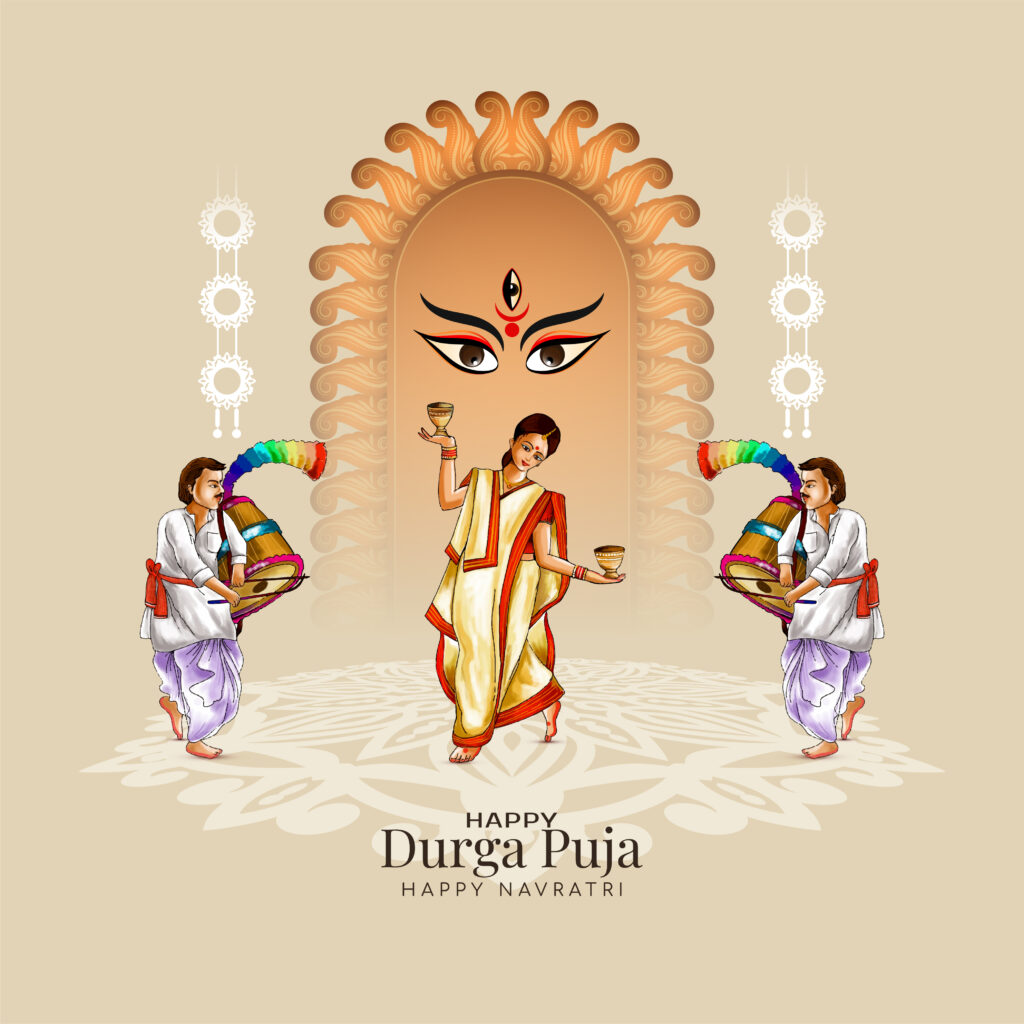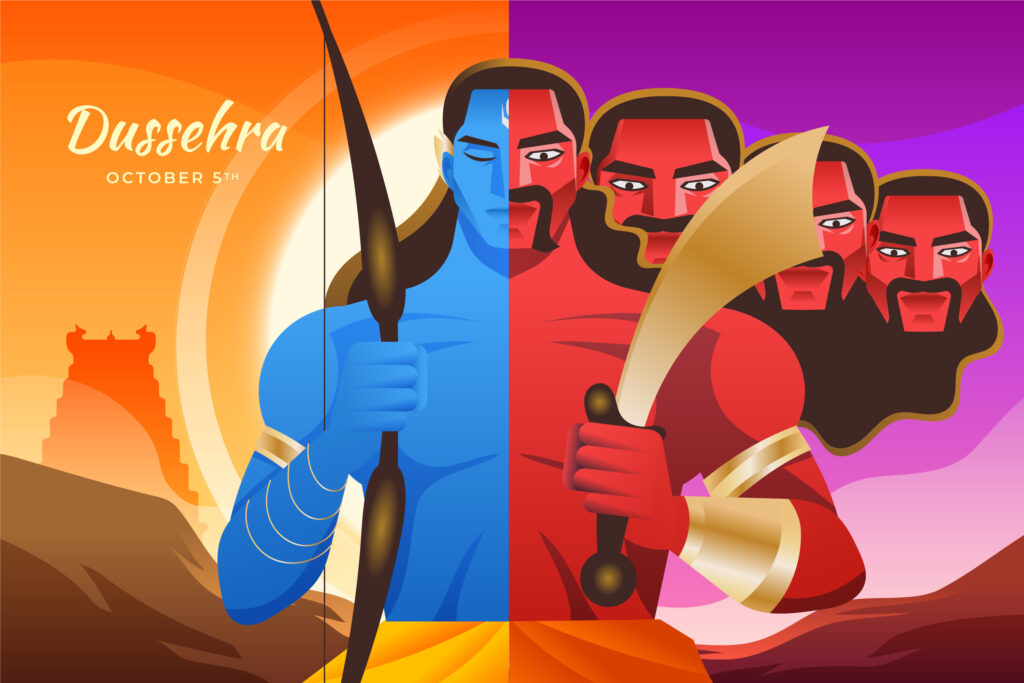Dussehra, also known as Vijayadashami, is among the most celebrated Hindu festivals in India. It symbolises the eternal triumph of good over evil. Falling on the tenth day of Navratri, Dussehra commemorates both Bhagwan Ram’s victory over the demon king Raavan (Ravana) and Goddess Durga’s slaying of Mahishasura.
Across the length and breadth of the country, communities observe this day with varied customs, making Dussehra a vivid reflection of India’s cultural diversity.
What is Dussehra?
The word “Vijayadashami” literally translates to “victory on the tenth day.” It follows the nine nights (Navratri) dedicated to the Divine Feminine (Shakti). In many parts of North India, the story recalled is that of Bhagwan Ram defeating Raavan.
While in East India (notably West Bengal), it coincides with the immersion (visarjan) of Goddess Durga idols after Durga Puja. The slaying of Demon Mahisasura happened on the ninth day (Navami) and Dashmi that coincides with Vijayadashmi is the celebration of good over evil.
The day holds dual significance, as it celebrates both the victory of dharma (righteousness) and the divine feminine force.
Historically and culturally, Dussehra blends mythology, ritual, drama, and community celebration.
Dussehra 2025: Date, Time & Muhurat
- Date: Thursday, 2 October 2025
- Dashami Tithi: Begins 1 October at 7:01 PM and ends 2 October at 7:10 PM
- Vijay Muhurat: Between about 2:05 PM and 2:53 PM on 2 October (Aparahna window)
- Raavan Dahan (effigy burning): Scheduled for evening (Pradosh Kaal) around 6:05 PM on 2 October
This year is especially noteworthy because Dussehra, Gandhi Jayanti, and Lal Bahadur Shastri Jayanti coincide on 2 October. It is a rare alignment that has occurred in decades.
Dussehra is a national public holiday, with schools, government offices, and banks closed for the day across India.
Historical Significance of Dussehra
Bhagwan Ram (Lord Rama) and Raavan (Ravana)
The central narrative in many parts of India is derived from the Ramayana. Ravana, the mighty demon king of Lanka, abducted Mata Sita. Shri Ram, along with his brother Lakshman Ji, Hanuman Ji, and an army of warrior monkeys, waged a long battle to rescue her.
On the tenth day, he slew Ravana, symbolising the triumph of virtue over vice. The burning of Ravana’s effigy (often along with those of his brother Kumbhakarna and son Meghnad) is a symbolic re-enactment of this victory.
Goddess Durga and Mahishasura
In the eastern and northeastern regions (especially West Bengal, Assam, Odisha), Dashmi (Dussehra) marks the culmination of Durga Puja. According to history, Goddess Durga waged a fierce nine-day battle against the buffalo-demon Mahishasura. On the tenth day, she vanquished him, restoring cosmic balance. This is rooted in the Devi Mahatmya (also known as Durga Saptashati) tradition.

Regional and Alternate Legends
In some southern and western states, Ayudha Puja (worship of tools, weapons, instruments) is observed on Dussehra, linking it to martial and professional life.
In certain areas, legends say Arjuna revealed the Gandiva bow (hidden during exile) to his mother on this day.
The festival is also a favourite moment to begin new ventures, education, or purchase new items, linking myth with practical life.
Rituals & Traditions of Dussehra
Dussehra is a tapestry of rituals, theatre, community gatherings, and devotion. Key elements include:
Ram Leela
Dramatic enactments of episodes from the Ramayana are staged over several nights, culminating on Vijayadashami with the climactic battle and the burning of Raavan.
Raavan Dahan
At dusk, large effigies of Raavan, Meghnad, and Kumbhakarna are set ablaze, often accompanied by fireworks and communal chanting.
Aayudha / Shastra Puja
In southern states such as Tamil Nadu, Karnataka, Andhra Pradesh, and Kerala, people clean and worship their tools, vehicles, instruments, books, and weapons, viewing them as extensions of divine energy.
Devi Visarjan
In Bengal and parts of East India, the idols of Goddess Durga are immersed (visarjan) in rivers or lakes, signifying her return to her cosmic abode.
Cultural Fairs and Processions
Streets come alive with fairs, processions, music, dance, and community feasts.
Dussehra Celebrations Across India: Regional Variations
India’s diversity is on full display during Dussehra. Some key regional flavours:
North India: Dominated by Ram Leela and the burning of Ravana effigies in public grounds.
West Bengal/East India: Durga Puja concludes with visarjan, where crowds gather on riverbanks to bid farewell to the Goddess.
Karnataka (Mysuru Dasara): One of India’s grandest celebrations. The Mysore royal family leads a spectacular procession of caparisoned elephants, horses, cultural performances, and illumination of the Mysore Palace.
Himachal Pradesh (Kullu Dussehra): Runs for a week (2–8 October in 2025) and is known for gathering deities from nearby regions in procession, folk music, dance (Nati), and tribal festivities.
Maharashtra: A special custom is the exchange of Apta (apta) leaves, believed to symbolise gold. People greet each other by giving these leaves as a token of prosperity.
Tamil Nadu / South India: Along with Ayudha Puja, the Golu (arrangement of dolls) tradition is prominent, connecting stories of gods, nature, and mythology.
Odisha / Assam: Emphasis on devotion, community processions, and immersion rituals.
Despite their varied forms, the core ethos, the victory of righteousness over evil remains constant.
Food, Feasts & Festive Delights
No Indian festival is complete without food. On Dussehra, people savour on;
Sweets & Delicacies: Jalebi, Barfi, Laddoo, Kheer, Kesari, Payasam.
Savoury Dishes: Traditional regional fare depending on state — biryani, pulav, sabzis, puris, and more.
Prasad: Items offered to deities during puja are later shared among devotees as blessed food.
Community Feasts (Bhandara): Free food for devotees, especially at temples or religious grounds, reinforcing social unity and charity.
Spiritual & Cultural Significance
Dussehra is more than a spectacle and cultural legacy; it carries profound moral, spiritual, and civic lessons:
Triumph of Truth and Virtue: It reinforces that no matter how powerful wrongdoing may seem, truth prevails in the end.
Inner Victory: Symbolic of conquering inner demons—anger, greed, ego, jealousy.
New Beginnings: The auspicious muhurat of Vijayadashami is considered ideal for starting new enterprises, pursuing education, launching a business, or purchasing property.
Community & Harmony: The festival brings people together, including neighbours, villages, towns and strengthens bonds of shared culture and values.

Conclusion
Dussehra or Vijaydashmi is all about the ultimate victory of Good over Evil despite hurdles, challenges, and setbacks. The core meaning of Dussehra applies to all human beings on a broader scale. Read the passage, learn life lessons from these historical events and stories, and be a good person and destroyer of inner evil because “Ram” and “Raavan” reside within us.
Frequently Asked Questions
What is the meaning of Dussehra?
“Dussehra” or “Vijayadashami” essentially means “victory on the tenth day.” It commemorates the triumph of righteousness over evil.
Why do we celebrate Dussehra?
We celebrate Dussehra to honour Lord Rama’s victory over Ravana and Goddess Durga’s defeat of Mahishasura—symbolising the triumph of dharma over adharma, and light over darkness.
When is Dussehra in 2025?
In 2025, Dussehra (Vijayadashami) falls on 2 October 2025.
What is the importance of Vijay Muhurat on Dussehra?
Vijay Muhurat is the auspicious time on Dussehra to perform rituals, offer prayers, or commence auspicious activities. Activity during this window is believed to confer blessings, success, and prosperity.
What happens in West Bengal on Dussehra?
In West Bengal, Dussehra coincides with the culmination of Durga Puja. Idols of Goddess Durga are immersed (visarjan) in rivers or water bodies after days of worship and celebration.
What is Mysuru Dussehra famous for?
Mysuru Dasara (in Karnataka) is renowned for its grand royal procession of richly decorated elephants, cultural events, the illumination of the Mysore Palace, and the involvement of the erstwhile royal family. It is one of India’s most spectacular festival spectacles.
Is Dussehra considered auspicious for new beginnings?
Yes. Dussehra (especially during Vijay Muhurat) is widely considered an auspicious time to start new ventures—such as business, education, vehicle or home purchase—believed to bring success and positivity.
About the Author
Biswajit Singh is a passionate writer and researcher specialising in Indian culture, festivals, and creative storytelling. With a background in literature and cultural studies, Biswajit Singh combines traditional and modern perspectives to help readers connect deeply with their heritage. Over the years, he has contributed articles to local newspapers, journals, and digital media on topics relating to Indian festivals, traditions, history, and cultural heritage.

3 thoughts on “Dussehra 2025: Tradition, Importance, and Celebrations Across India”